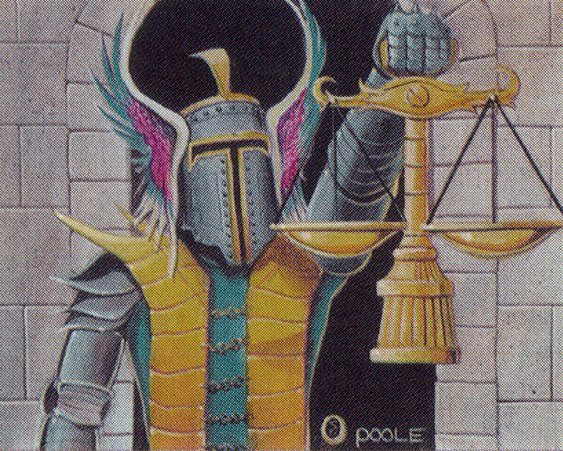I haven’t played Old School since 1994, and the restricted list was a bit different back then, but I happen to own some old cards. I’m going to Gen Con, and I have fond memories of playing with said old cards as a kid at Gen Con in this mid 90s. I haven’t been to Gen Con in a few years, so to really maximize the nostalgia, I put together an Old School deck to play in some events there.
If you know anything about me, you should expect that my approach to putting this deck together didn’t involve researching decks other people have played in the format. I put together a list that looked like it could play the kind of game I want to play with the cards I want to cast. I haven’t played any games with it, and don’t expect to until my first event unless I’m lucky enough to run into someone who has a deck before then, but I want to explain my thought process in building it.

Kird Ape by Ken Meyer Jr.
My approach to Old School is similar to my approach to Premodern. Both are informed by differences in how cards were designed then compared to now. Simply put, instants and sorceries were a lot better than creatures in the 90s than they are now. In particular, answers were more versatile and efficient and threats demanded less specific answers. Swords to Plowshares just works. It stops whatever your opponent is trying to kill you with in a mana positive way. Anything Swords to Plowshares doesn’t answer, Disenchant probably will.
Creatures are so bad and answers to creatures are so good that I don’t really want to get involved with playing creatures. But how do you win without creatures? By having a better deck I guess, who cares, we’ll get to that later.
Card advantage is king in Old School. There are very few cards which draw extra cards. Since answers are so much more important than threats, “tempo”, as in ending the game before your opponent has had the mana required to use their cards, is very rarely relevant. Cards like moxen and Black Lotus make it so easy to get the mana to empty your hand.

Jayemdae Tome by Mark Tedin
Back in the 90s, I’d play Jayemdae Tome to draw extra cards, but with unrestriction of Ivory Tower in Old School, I no longer think that’s necessary. Instead, I can use Sylvan Library and offset the life payment with Ivory Tower’s life gain. Ivory Tower+Sylvan Library is Old School’s Land Tax+Scroll Rack.
To make that work, you need a lot of cards in hand. Incidentally, the best way to get a lot of cards in your hand is actually Land Tax, so I’m playing that too, even though Scroll Rack isn’t in the format. The card that shows my true dedication to the cause is Library of Leng, which allows me to skip my discard step so that I can keep putting more cards in my hand to gain more life with Ivory Tower, to keep fueling Sylvan Library to get more cards in my hand.
The Game Plan
Okay, let me start layout out the cards I’m working with here.
First, the efficient answers that allow me to play a control game:
- 4 Swords to Plowshares
- 4 Disenchant
- 4 Counterspell
- 1 Mana Drain (restricted)
Next, my card draw engine:
Now my concern is while I can draw a lot of cards, I only have so many actual answers in my deck–if my opponent has more than four creatures, I can’t answer all of them with Swords to Plowshares. Fortunately, I don’t really need to, as Ivory Tower’s life gain can let me ignore some creatures, and I can counter some creatures, but the point stands that a deck like this can just run out of relevant interaction, since Gaea’s Blessing isn’t in the format.

Ivory Tower by Margaret Organ-Kean
I have a plan for that, which is to loop my deck anyway thanks to two restricted cards:
- 1 Timetwister
- 1 Regrowth
As long as I can resolve whichever of these I’m casting while the other’s in my graveyard, I can recycle the other cards in my deck to keep finding more answers. The problem is my entire strategy is based on holding more cards than my opponent, so casting Timetwister is pretty counter productive. My goal is only to do it once, I’m so firmly ahead that giving my opponent a new hand won’t really matter. To accomplish that, my deck has some prison elements.
Icy Manipulator can tap my Winter Orb on my opponent’s turn so I can untap my lands and they can’t untap theirs. It can tap my opponent’s lands so that they can’t make progress on untapping their lands. My opponents will generally have moxen which will allow them to function without needing to use their lands, but eventually I can Disenchant those, or restrict their mana enough that I’m not too worried about refilling their hand.
And to help get to that point, I have an intermediate option to reuse my important cards.
- 1 Recall
Recall exiles itself, but with Land Tax, I can discard a bunch of basic lands I don’t need to reuse whatever important answers I’ve already cast.

Balance by Mark Poole
Of course, Old School’s defining feature is its restricted cards, and while most of them are powerful enough to play regardless of your strategy, they certainly inform deckbuilding and game play. Specifically, I’m playing the following cards I haven’t already listed:
- 1 Balance
- 1 Demonic Tutor
- 1 Mind Twist
- 1 Time Walk
- 1 Brain Geyser
- 1 Ancestral Recall
- 1 Black Lotus
- 1 Chaos Orb
- 1 Mox Pearl
- 1 Mox Sapphire
- 1 Mox Jet
- 1 Mox Ruby
- 1 Mox Emerald
- 1 Sol Ring
- 1 Strip Mine
Demonic Tutor is fairly important for either finding other restricted cards or assembling my card draw engine. Balance is my mass removal spell, which combines really well with the large number of artifacts and enchantments I’m playing, especially Icy Manipulator, which forces my opponent to overextend into Balance.
I want to minimize my risk of having my Regrowth+Timetwister loop disrupted, so I’m playing some cards to make sure both resolve:
Disrupting Scepter is the old control mirror breaker–if your opponent can’t kill it, they’ll have to discard too many cards to really be able to fight you. My deck is relatively good against it because of Land Tax and Sylvan Library, but it’s still one of the most important cards in any control mirror. Power Sink allows me to force my opponent to tap out, which is good if they’re trying to play through Winter Orb. It gives me a free turn to know I can resolve key spells because there are no free spells in the format.
Ok, so that covers my basic game plan, now, about that winning issue. I want play the smallest number of cards that solely try to end the game possible, so here’s my plan:
Millstone allows me to further tax my opponent’s Disenchants without letting them get any value out of their Swords to Plowshares, and will kill my opponent eventually. Tormod’s Crypt means my Timetwister won’t give them any of their cards back, so even if they always answer my Millstone, I can still eventually deck them with Timetwister returning my graveyard and not theirs.

City of Brass by Mark Tedin
That just leaves the mana.
This is the part I’m really not sure about. Aside from restricted cards, I’m playing:
- 1 Fellwar Stone
- 3 City of Brass
- 3 Tundra
- 4 Island
- 3 Plains
- 1 Swamp
- 1 Forest
I know I want roughly that many basic lands for Land Tax. I have no idea how many Fellwar Stones are correct–they’re good with Icy Manipulator, Balance, and Winter Orb, and sometimes they’ll be good fixing. But it’s unreliable and unpredictable; most of my cards don’t need a lot of mana.
City of Brass and Tundra, I also don’t know how many I need. I know those are the best nonbasic lands for getting the colors of mana I need, but I don’t know if I should be playing four of one and two of the other, or more or less total. It’s genuinely very had to figure out how much mana I need in a deck with Land Tax and only needs two or three mana sources to operate for a while, but can use more eventually. If I played a lot, I’d probably get a better sense of it eventually, but I really don’t have that many chances to play Old School, so I’m kinda guessing.
That’s a 65 card main deck. Playing 65 cards in a format where Power 9 are legal but restricted is kind of wild, in that I’m decreasing my chances of drawing Library of Alexandria, Black Lotus, and Ancestral Recall in my opening hand, but I expect my games to go long enough that I’ll find those cards eventually anyway. This was the number of cards needed to fit all the tools I wanted, and I’m also happy to decrease my chances of drawing cards I don’t want to see early, like Tormod’s Crypt and the extra basics I’m playing to find with Land Tax.
The Sideboard
Because I’m playing 65 cards, I’m only playing a 10 card sideboard, so that I can choose to play only 60 whenever I want in the second or third game.
My sideboard:
Against creatures:
Against Control:
Triskelion might not be right, It’s very expensive and not all that good. It theoretically lets me punish people for cutting creature removal, but it still dies to artifact removal. Something like Serendib Djinn might be a better way to punish people for cutting creature removal, but I own an Antiquities Triskelion, and it’s one of my favorite physical cards, so I figured I could spare a sideboard slot for it.
Sam Black (any) is a former professional Magic player, longtime Magic writer, host of the Drafting Archetypes podcast, and Twitch streamer. Sam is also a Commander Cube enthusiast, and you can find Sam’s cube list here. For anything else, find Sam on Twitter: @SamuelHBlack.

